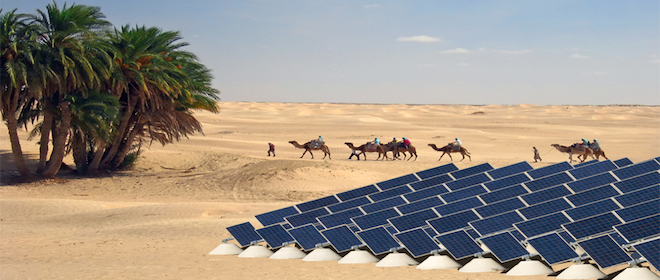The energy transition towards renewables has recently seen an increase in Middle Eastern countries, especially in Saudi Arabia, UAE, Egypt, Morocco etc. Once dependent on its plentiful reserves of oil and gas for wealth, the region is finally embracing the zero-carbon emission goals.
As per IRENA’s World Energy Transitions Outlook (WETO), the region could obtain almost 26 per cent of its total primary energy supply from renewables by 2050, and its total renewable share could reach up to 53 per cent in the power sector. With that, the region would be able to achieve emission reduction equivalent to 1.1 Gt CO2/yr.
The region is building up on its renewables including hydrogen. On the green hydrogen front, the Middle East has put forward plans to meet demand from export markets and hard-to-abate sectors. Several big projects are being planned for meeting the region’s renewable goals. It’s worth noting some of the game-changing Renewable Energy Projects In the Middle East. We look at the top projects which have the potential to give a significant push to the region’s renewable future.
Mohammed bin Rashid Al Maktoum Solar Park
Location – Dubai, UAE
Capacity – 5000 MW
The Mohammed bin Rashid Al Maktoum Solar Park is the largest single-site solar park in the world based on the Independent Power Producer (IPP) model. The project has a planned production capacity of 5,000 MW by 2030, with investments totalling AED 50 billion ($13.6 billion). On its completion, the project will save over 6.5 million tons of carbon emissions annually.
The Dubai Clean Energy Strategy 2050 and the Dubai Net Zero Emissions Strategy 2050 aim for clean energy to contribute to 100 per cent of energy production capacity by 2050. The development of Mohammed bin Rashid Al Maktoum Solar Park in phases is a leap toward the same goal.
The Mohammed bin Rashid Al Maktoum Solar Park contributed to Dubai Electricity and Water Authority (DEWA) winning the Best Sustainable Project of the Year in the UAE at the 2014 MEED Quality Awards – the first time this award was given to a renewable energy project in the Middle East and North Africa (MENA) region.
Shuaibah Two (2) Solar Facility
Location – Mecca Province, Saudi Arabia
Capacity – 2060 MW
Saudi Arabia’s private utility ACWA Power and the Water and Electricity Holding Company (Badeel), a subsidiary of the Saudi Public Investment Fund (PIF) signed agreements for the establishment of the largest in Saudi Arabia and among the biggest renewable energy projects planned in the Middle East. The project will be located in Al Shuaibah in Mecca province which is expected to power around 350,000 homes by the end of 2025.
The agreement entails the project being owned between Badeel and ACWA Power, each holding a 50 per cent stake in it via the establishment of the Shuaibah Two Electrical Energy Company. The project marks a key milestone toward PIF’s commitment to developing 70 per cent of Saudi Arabia’s renewable energy by 2030.
NEOM Green Hydrogen Project
Location – NEOM, Saudi Arabia
Capacity – 600 tons per day (Green Hydrogen)
NEOM Green Hydrogen Project is the world’s largest utility-scale, commercially-based hydrogen facility powered entirely by renewable energy. The project is a joint venture between NEOM, Air Products, and ACWA Power, integrating a combined capacity of around four gigawatts of renewable power from onshore solar, wind and storage. Supporting Saudi Arabia’s Vision 2030, the mega-plant will produce up to 600 tons per day of carbon-free hydrogen in the form of green ammonia.
Once operational the project will save the world almost five million metric tonnes of carbon dioxide (CO2) per year. The $5 billion green hydrogen plant will start its production in 2026.
Gulf of Suez Wind Power Project
Location – Gulf of Suez, Egypt
Capacity – 1100 MW
The 1.1 GW wind project will be located in the Gulf of Suez and Gabal el Zeit area of Egypt. The wind project is the largest single contracted wind farm in the Middle East region and one of the largest onshore wind farms in the world. On completion, the project is set to reduce about 2.4 million tonnes of carbon dioxide emissions per year, providing green electricity to 1,080,000 households.
The project is expected to become commercially operational by the end of the year 2026. ACWA Power estimated an investment value of $1.5 billion for the project.
Al-Ajban Solar Park
Location – Abu Dhabi, UAE
Capacity – 1500 MW
Emirates Water and Electricity Co. (EWEC) has recently issued a Request for Proposals (RFP) to qualified companies and consortiums that had expressed interest in developing the new Solar Photovoltaic (PV) Independent Power Project with a power generation capacity of 1,500MW (AC) to be located in the Ajban area of the Emirate of Abu Dhabi.
The project is expected to power approximately 160,000 homes across the UAE. Once operational, the project could reduce Abu Dhabi’s CO2 emissions by up to 2.4 million metric tonnes per year and increase solar capacity to approximately 4GW. Al Ajban Solar PV Project is one of the three solar power projects, the other two being the Noor Abu Dhabi and the Al Dhafra Solar PV Project, that will play a pivotal role in enabling the UAE Net Zero by 2050 strategic initiative as well as UAE Energy Strategy 2050.


